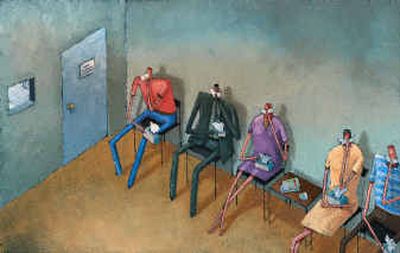CONTROL

So you’re sick and find yourself plopped down in a doctor’s waiting room.
You can’t help noticing that your fellow patients don’t look so hot. Some cough. Some loudly negotiate with their phlegm. And a few just stare straight ahead in half-dead stupors.
The thought occurs to you: Good grief, surrounded by all these ill people, am I apt to catch something that I don’t already have?
It could happen, said Dr. Paul Stepak, epidemiologist at the Spokane Regional Health District.
But, he added, you could also come down with something after visiting a church bazaar, a day-care center or just about anywhere that people are in close quarters.
“Any time you have people kind of packed in with each other,” he said.
Now the presence of a potentially higher percentage of already-unwell people in the medical waiting room might skew things a little. But the sneezer next to you at your workplace could well be your undoing, not that much-handled copy of the National Geographic at the doctor’s office.
There really aren’t definitive statistics about the health hazard posed by spending time in a doctor’s waiting room, said Dave Daigle of the National Center for Infectious Diseases.
It could be that the incidence of nonemergency patients catching something from other patients is underreported. But Dr. Estella Whimbey doubts that there is a compelling reason for alarm.
“We simply don’t hear many reports of transmissions in medical offices,” said Whimbey, director of epidemiology and infection control for the University of Washington Medical Center.
Which doesn’t mean you shouldn’t use your head while slouched there by the tropical fish tank, waiting for your name to be called.
Different diseases are transmitted in different ways. But if someone is sneezing or coughing and generally spewing a volcanic volume of germs without making any effort to cover his or her mouth, be smart. Don’t sit near that person.
Last winter, the health district encouraged local medical offices to offer masks to patients suffering from respiratory illness. And partly in response to concerns raised by SARS, public health officials across the country have promoted what they term “respiratory etiquette.”
In essence, this calls for sick people to share responsibility for seeing that they don’t pass their maladies along to others.
“Cover Your Cough” says one poster.
“It’s Up to You to Stop Germs in Their Tracks!” declares another.
Of course, calling on people to be considerate is always a hit-or-miss proposition.
Chances are the worst thing you’re apt to catch at a doctor’s office is a cold. For patients with compromised immune systems, however, even a common virus can pose real danger.
Again, though, waiting rooms are not the only places such individuals might be exposed to malicious microbes.
“Since sick people tend to concentrate in doctors’ offices, one might assume that the risk is greater there,” said Dr. Kim Marie Thorburn, chief medical officer for the health district. “But they’re certainly no worse than airplanes with their recirculated air.”
Not all doctor’s offices have infection-control protocols to rival those in place at hospitals. But many have moved toward easy-to-scrub interior design and toys that can be disinfected.
“The fuzzy, huggy bear is very hard to clean,” said Stepak.
Still, there’s no way to altogether avoid sick people in a waiting room.
So what do you do? Hold your breath?
“The best protection is always that mundane thing your grandmother told you,” said Stepak. “Wash your hands.”
Washing your hands greatly reduces the chance that some microscopic bad guys you’ve picked up will be passed along to your mouth, eyes or nose, where they can start real trouble.
“Far more diseases are transmitted by contaminated hands than by things floating through the air,” said Stepak.
Another way to help make a waiting room a reasonably safe environment is for appointment schedulers to think ahead about who will be coming to the office.
“More and more, people are triaging on the phone for possible communicable diseases so that those patients can be offered a mask, scheduled at the end of the day or taken immediately to an examining room,” said the UW’s Whimbey.
She predicted that these issues will receive increasing scrutiny as more tests and procedures formerly conducted in the hospital migrate to outpatient settings.
So if you need to see a doctor, should you be scared off by the prospect of cooling your heels in a waiting room full of sniffers and hackers?
No, said Whimbey.
“If one has an illness, one should by all means go to the people who are there with the knowledge and dedication to help make them better,” she said.
Just remember to wash your hands.